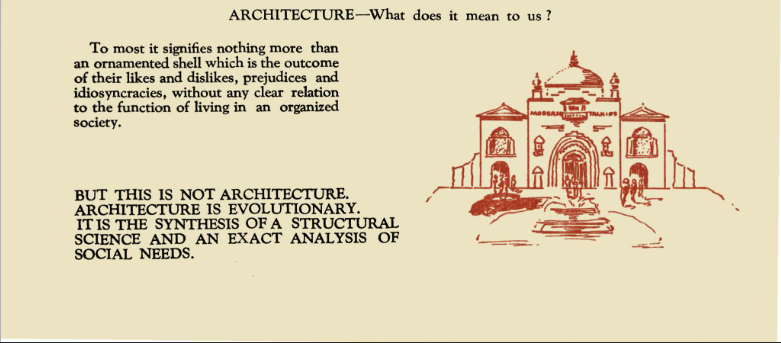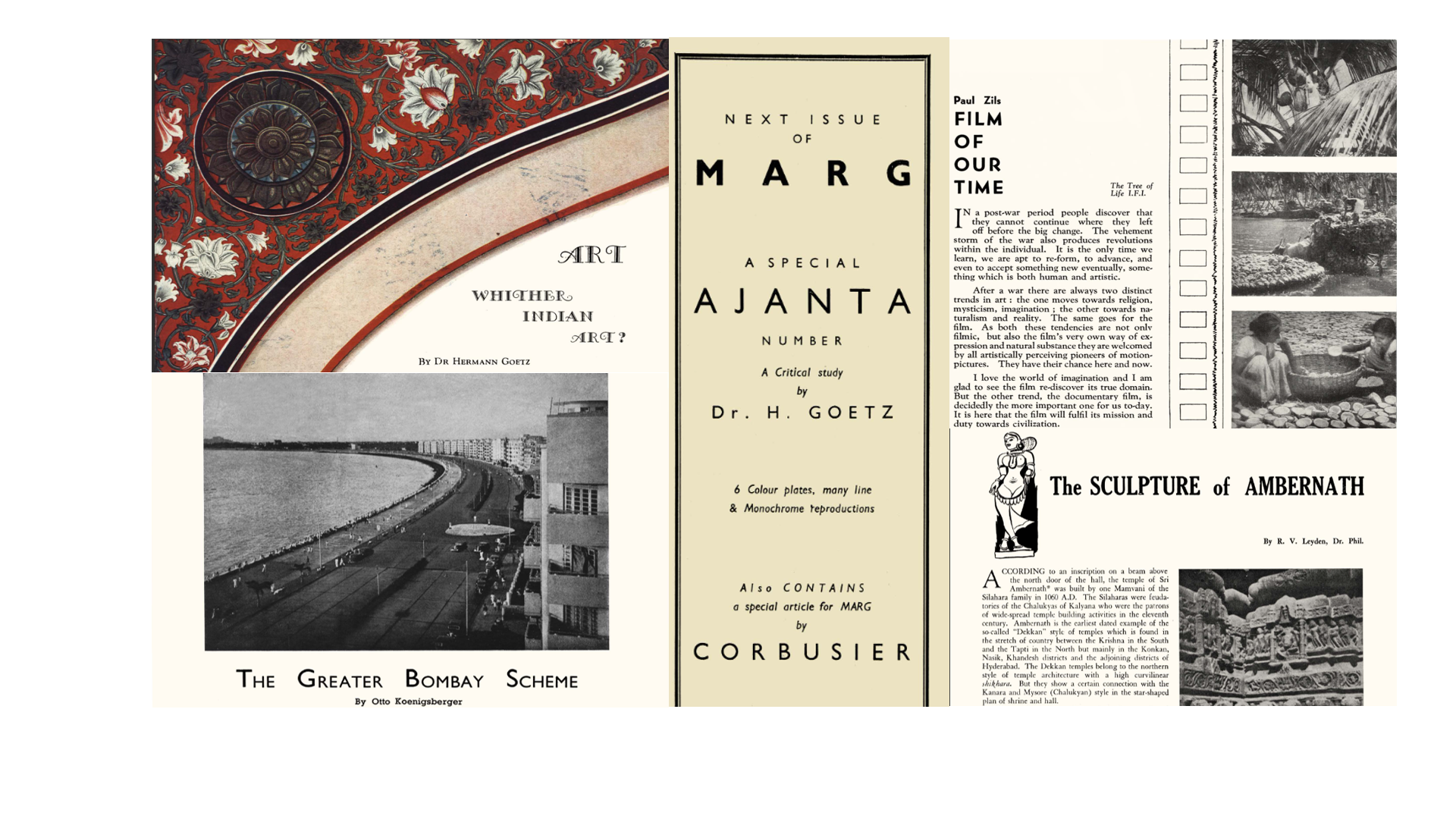Archive
Marg. A Magazine of Architecture and Art
- Magazine
Marg. A Magazine of Architecture and Art
Word Count: 7
- MARG, Marg. A Magazine of the Arts
- Mulk Raj Anand
- 1946
25 Cuffe Parade, Colaba, Bombay (now Captain Prakash Pethe Marg, Mumbai); 3 Queens Road, Marine Lines, Bombay (now Khatau Road, Mumbai).
- English
- Mumbai (IN)
Local and exiled creatives formed the Modern Architectural Research Group to publish a progressive journal of art and architecture in Bombay from 1946 onwards.
Word Count: 23

Cover of the first issue, detail (Marg, vol. 1, no. 1, 1946, reproduced with the permission of The Marg Foundation, Mumbai, India). 
Cover of the first issue (Marg, vol. 1, no. 1, 1946, reproduced with the permission of The Marg Foundation, Mumbai, India). 
Advert MARG means Pathway (Marg, vol. 1, no. 2, 1947, p. 110; reproduced with the permission of The Marg Foundation, Mumbai, India). 
Editors’ page of the first Marg issue (Marg, vol. 1, no. 1, 1946, p. 1; reproduced with the permission of The Marg Foundation, Mumbai, India). 
Excerpt from “Architecture and You” (Marg, vol. 1, no. 1, 1946, p. 10; reproduced with the permission of The Marg Foundation, Mumbai, India). 
A collage of exiles’ contributions to Marg (All images reproduced with the permission of The Marg Foundation, Mumbai, India). Editorial “Planning and Dreaming.” (Marg, vol. 1, no. 1, 1946, p. 4f). Dalvi, Mustansir. “Mulk and Modern Indian Architecture.” Mulk Raj Anand: Shaping the Indian Modern, edited by Annapurna Garimella, Marg Publications, 2005, pp. 56–65.
De Mel, Neloufer. Women & the Nation’s Narrative: Gender and Nationalism in Twentieth Century Sri Lanka. Rowman & Littlefield, 2001.
De Silva, Minnette. The Life & Work of an Asian Woman Architect. Smart Media Productions, 1998.
Deboo, Khorshed. “Revisiting the Past, Reimagining a Future. How an Art Magazine Found a Place in Indiaʼs Nation-Building Narratives.” Himal Southasian, 16 February 2021, www.himalmag.com/revisiting-the-past-reimagining-a-future-2021/. Accessed 20 March 2021.
Kulke, Hermann. “Life and Work of Hermann Goetz.” India and the West. Proceedings of a Seminar Dedicated to the Memory of Hermann Goetz (South Asian Studies, 15), edited by Joachim Deppert, New Delhi, 1983, pp. 13–23.
Lee, Rachel, and Kathleen James-Chakraborty. “Marg Magazine: A Tryst with Architectural Modernity.” ABE Journal, no. 1, May 2012. abe.revues.org, doi: 10.4000/abe.623. Accessed 20 March 2021.
Metcalf, Thomas R. An Imperial Vision: Indian Architecture and Britain’s Raj. University of California Press, 1989.
Sales-Pontes, Alzira Hilda. Dr. Mulk Raj Anand – A Critical Bibliography (Doctoral thesis, Loughborough University Of Technology, 1985), www.hdl.handle.net/2134/10854. Accessed 27 April 2021.
Singh, Devika. “German-Speaking Exiles and the Writing of Indian Art History.” Journal of Art Historiography, no. 17, December 2017, pp. 1–19. DOAJ, doaj.org/article/0971436ed0004ecfa1f89d7a6d9d0628. Accessed 28 April 2021.
Word Count: 210
Marg, vol. 1–4, Marg Publications, 1946–1953, https://marg-art.org/.
Word Count: 7
We would like to thank Marg (Anjana Premchand, Mrinalini Vasudevan) for their support of our research.
Word Count: 16
- Bombay
- Rachel Lee; Mareike Schwarz. "Marg. A Magazine of Architecture and Art." METROMOD Archive, 2021, https://archive.metromod.net/viewer.p/69/2951/object/5140-8103274, last modified: 15-09-2021.
-
Mulk Raj AnandWriterPhilosopherArt PatronCultural CriticBombay
As a global socialist and modernist, Mulk Raj Anand sought and shaped opportunities for intellectual exchanges between Asia and Europe.
Word Count: 20
Kekoo Minochair GandhyFrame Shop OwnerGalleristArt CollectorBombayStarting from a cosmopolitan milieu for young local artists, Kekoo and his wife Khorshed Gandhy developed a business model that turned the frame shop into Gallery Chemould.
Word Count: 27
Rudolf von LeydenGeologistAdvertisement SpecialistJournalistArt CriticArt CollectorCartoonistBombayThe advertisement expert, Rudolf von Leyden, became a major art critic and art historian in Bombay in the 1940s, advocating an urgent need for modernism in art in post-colonial India.
Word Count: 30
Minnette De SilvaArchitectJournalistBombayProbably the first Sri Lankan woman architect and a founding member of Marg, Minnette De Silva mediated between tradition and modernity while defying the boundaries of gender, caste and disciplines.
Word Count: 30
One Man exhibition and subsequent trial, Akbar PadamseeCourt CaseBombayAkbar Padamsee’s solo exhibition in Bombay in 1954 was overshadowed by his arrest on charge of displaying obscene pictures. The subsequent court case drew support from across the art world.
Word Count: 30
The Feldberg Art Collection. A Series of Three Exhibitions of European Artworks collected by the Feldberg FamilyExhibitionBombayIn 1950 the Institute of Foreign Languages organised three exhibitions of paintings from the collection of the exiled Jewish manufacturer Siegbert Feldberg and his wife Hildegard from Stettin.
Word Count: 27
Homi Jehangir BhabhaScientistCollectorArtistBombayHomi Jehangir Bhabha was a world class scientist, institution builder, an artist and art connoisseur. His vision for growth of science and art has had significant impact in post-colonial India.
Word Count: 30
ChemouldGalleryFrame ShopBombayChemould’s history stretches from its beginnings as a manufacturer of chemical mouldings and frames in 1941 over to a hub for art circulation displaying a variety of artists in Bombay.
Word Count: 30
TIFRUniversity / Higher Education Institute / Research InstituteBombayThe TIFR is one of India’s premier scientific institutions. Inside its buildings, scientists ponder over path-breaking ideas. Also, within its hallowed walls is a fine collection of modern Indian art.
Word Count: 31
Institute of Foreign LanguagesLanguage SchoolExhibition SpaceLibraryTheatreBombayWith its wide range of cultural activities, the Institute of Foreign Languages − founded in 1946 by the Viennese emigrant Charles Petras − became a glocal contact zone in Bombay.
Word Count: 27
Iconic Photo of the Progressive Artists’ Group and Their AssociatesPhotographBombayThere are two versions of the PAG photo at the opening of M.F. Husain's first solo exhibition in 1950 (published in 1996 and 2003) and two narratives about the opening.
Word Count: 28